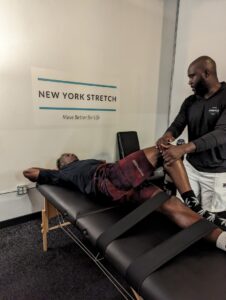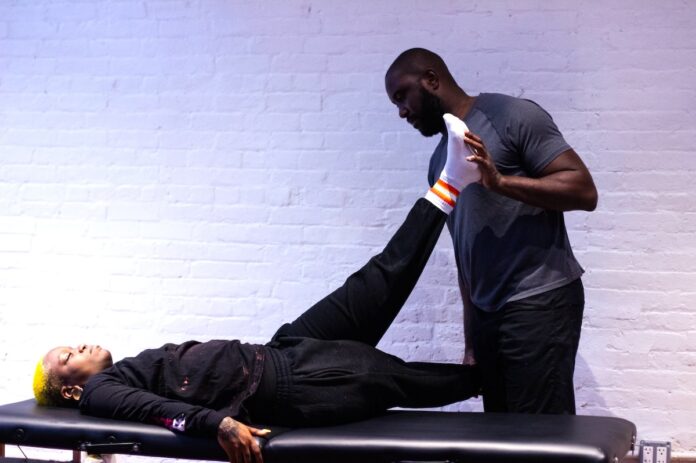If you have ever worked out with a personal trainer, one of the most anticipated moments is the stretching that occurs at the end of the session. But even if you haven’t, you can probably recall a time when you wished someone could help you stretch to alleviate some discomfort you might be feeling in your body.
Your healthcare provider may have referred you to physical therapy if the pain was acute. But now, stretch therapy studios are popping up nationwide to help those who need to improve flexibility and mobility. We talked to Michael Okech, co-founder of New York Stretch, about the value of stretch therapy and how it can improve the quality of our lives as we age.
Stretching Essential for Good Health
Our day-to-day aches and pains, including shoulder and neck discomfort and lower back pain, impact our mobility. Okech, a Postural Restoration practitioner, says, “When you don’t have good mobility, you can’t move well. It can decrease the quality of your workouts. reduce your activity levels and affect your cardiovascular health and blood sugar,” he explains. “In our sessions, we work on increasing joint mobility and improving tissue health.”
Decreased mobility also increases the physical signs of aging. “Mobility is a big marker for age. The key things that I look at are cardiovascular health, mobility, and muscle and bone density,” he says. “But if someone moves well, you probably will think they are younger.”
When We Don’t Have Good Mobility, We Compensate in Other Ways
The areas most needing stretching are the lower back, hips, neck, and shoulders, which sometimes causes migraines. But Okech points out that when there’s dysfunctional movement elsewhere, you tend to compensate by using your lower back.
But we often overlook our feet. “There’s a lot of tightness in the ankles and feet because we use them a lot,” he explains. “Wearing shoes and boots, especially in winter, will lock your feet and ankles. You get less sensation and strength.”
What to Expect During a Stretch Therapy Session
Stretch therapy is also known as table-based assisted stretching. You wear workout clothes for the session, but unlike physical therapy, this is a passive experience (you don’t do anything). Okech explains that practitioners start with an assessment with the client on their back. They look at their client’s range of motion. Then, they measure what they see versus how their clients describe their feelings and restrictions before beginning the session, which could last up to one hour.

Okech says stretch therapists use certain principles or techniques during the session:
- Traction, which involves pulling on the body to create joint space. It calms the nervous system and prepares the body to relax.
- Oscillation Shaking is another technique that calms the body.
- Circumduction moves the limb in circular patterns, which gets the joints to relax further.
- Full-body three-dimensional stretch.
“When I say three-dimensional, we’re looking at every range of movement,” Okech explains. “We view the body as a spiral. We are trying to unwind it and get the tissue to almost massage itself.”
One Session Won’t Get You Lasting Results
Okech notes that stretch therapy is like working out or making nutritional changes to your diet. It is a long-term, continuous wellness practice. How often you want to do it could depend on your age and willingness to supplement the assisted stretching with at-home practices. So, while stretch therapy sessions are passive, you must do the homework.
“For the work to stick, you must do a lot on your own,” he says. “The goal is to build your own program.”
But if you are looking for a place to start before you get to assisted stretching, Okech recommends walking as a starting point to improve function. “We’re born to walk and run,” he says. “It’s simple, it’s cheap, it’s free. The more you move, the more range of motion you have.”






